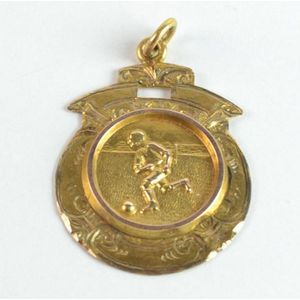18th/19th Century French Gold Enamel Scene Watch
You must be a subscriber, and be logged in to view price and dealer details.
Subscribe Now to view actual auction price for this item
When you subscribe, you have the option of setting the currency in which to display prices to $Au, $US, $NZ or Stg.
- Fusee - The fusee movement was used in clocks and pocket watches from the mid 17th century. The fusee is a cone shaped drum within the works that is linked to the barrel of the spring, usually by a length of chain.
As the mainspring loses its tension over time, the cone shaped barrel compensates for this by increasing the tension, by pulling the mainspring tighter, thus ensuring the time remains constant.
Use of the fusee in clocks was superseded by the "going barrel" in the mid 19th century and for pocket watches at the beginning of the 19th century.
The fusee continued to be used in marine chronometers until the 1970s. - Polychrome - Made or finished in many colours. For furniture, it is used to indicated a painted finish.
- Verge Escapement - A verge escapement is an early mechanical escapement used in clocks and other timekeeping devices. It is an early form of the escapement mechanism, which is used to regulate the movement of the hands of a clock or watch. The verge escapement consists of a vertical shaft called the verge, which is mounted on the clock's main plate. Attached to the verge are two pallets, which engage with the teeth of the escape wheel. As the escape wheel turns, the pallets alternately lock and release it, allowing the movement of the clock to be regulated. The verge escapement was widely used in early mechanical clocks, but it was eventually replaced by the more accurate and reliable anchor escapement.
This item has been included into following indexes:
-
pocket watches, case type
- enamelled decoration 161
- open face, gold / gold-plated case 1,381
- pair cased 165
- pocket watches, period - Georgian 289
Visually similar items

A Western Australian Soccer club, 9ct gold fob, medal, engraved: 'Presented to R. Ward, Most Enthusiastic, Player, 1929-30, Welbungin Soccer Club, Western, Australia, 9ct APEX'

Gentleman's Hebdomas 8 Day half hunter watch, circa early 20th century, working when tested

18ct gold and diamond 'Happy Diamonds' pendant, Chopard centring an oval glazed compartment engraved Chopard Geneve enclosing three floating collets accented with brilliant-cut diamonds framed by a gold surround pave-set with diamonds, length approximately

Royal Crown Derby 'The 250 Collection' two handled floral dish (boxed)
